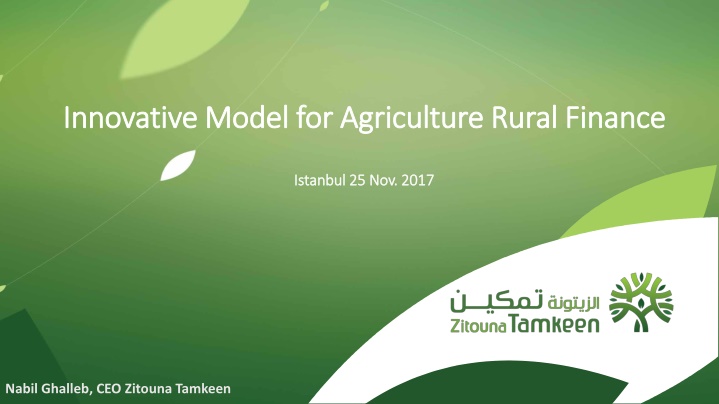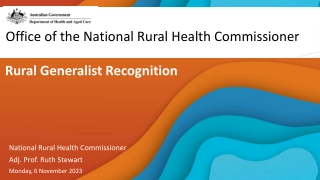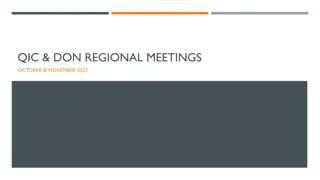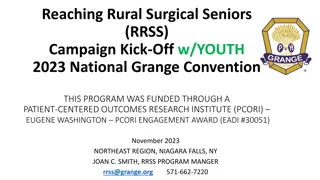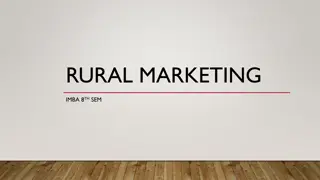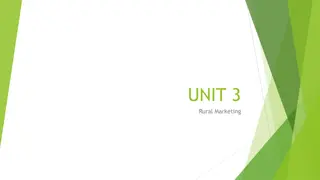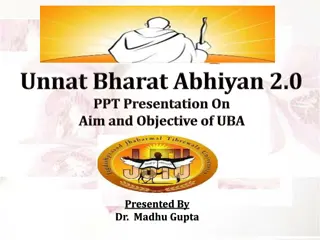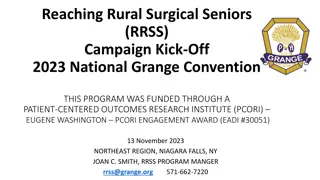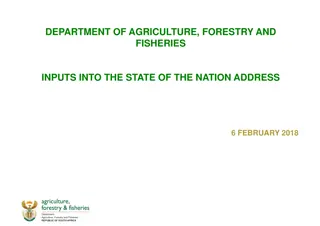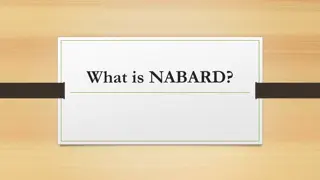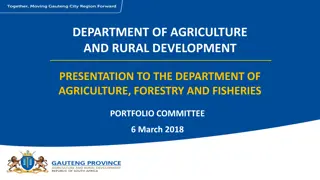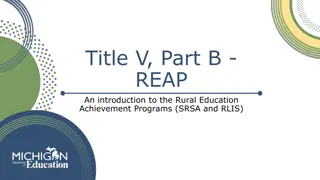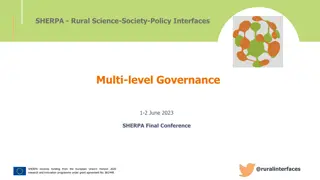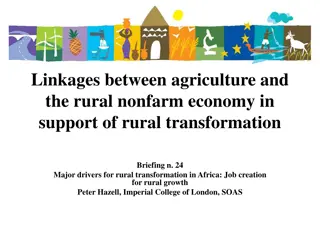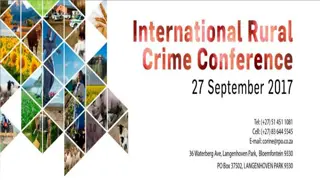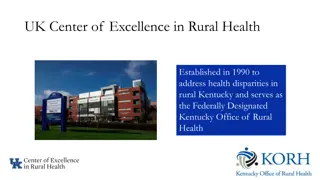Innovative Model for Agriculture Rural Finance in Istanbul
Zitouna Tamkeen is a microfinance institution in Tunisia focusing on economic empowerment through Islamic microfinance. Their vision is to support self-employment projects and become a key player in the Islamic microfinance sector nationally and internationally. With a unique economic empowerment financing model, they collaborate with various partners and operate through NGO, MFI, and consulting company structures.
Download Presentation

Please find below an Image/Link to download the presentation.
The content on the website is provided AS IS for your information and personal use only. It may not be sold, licensed, or shared on other websites without obtaining consent from the author.If you encounter any issues during the download, it is possible that the publisher has removed the file from their server.
You are allowed to download the files provided on this website for personal or commercial use, subject to the condition that they are used lawfully. All files are the property of their respective owners.
The content on the website is provided AS IS for your information and personal use only. It may not be sold, licensed, or shared on other websites without obtaining consent from the author.
E N D
Presentation Transcript
Innovative Model for Agriculture Rural Finance Innovative Model for Agriculture Rural Finance Istanbul Istanbul 25 25 Nov. Nov. 2017 2017 Nabil Ghalleb, CEO Zitouna Tamkeen
Summary Zitouna Tamkeen Economic Empowerment for Poverty Alleviation Innovative Model for Agricultural Rural Finance
Zitouna Tamkeen Economic empowerment for poverty alleviation Innovation model for agricultural rural finance
Who We Are Zitouna microfinance institution in Tunisia and was created with the intention to institutionalize empowerment financing approach by building a financial institution whose activity goes beyond financial inclusion and promotes vulnerable people empowerment and economic inclusion. tamkeen is the first and unique Islamic the economic Zitouna Tamkeen adopts the economic empowerment financing model and uses microfinance. This approach resourcefulness and opportunity to address critical social challenges. the combines tools of innovation, Islamic 4
Vision & Mission Mission Participate in the economic inclusion of disadvantaged populations through Islamic microfinance and support self-employment projects and initiative Vision Become a key player in Islamic microfinance sector at the national level and internationally 5
Capital Structure A Specialized Microfinance Fund A leading Islamic insurance company in Tunisia A leading Islamic bank in Tunisia Islamic Development Bank D lice Holding: a leading company in the dairy industry The state investment fund POULINA Holding: a leading company in Tunisia 6
Partnerships and Networking Partnerships with some key players in the civil society and public sector Advocacy and Training on Economic Empowerment and social finance Institutional partnerships A variety of profiles Research institutions Business centres Associations NGOs Public sector 7
How We Operate NGO MFI Consulting Company T4D Design of investment projects within the framework of EE Establishment of an adequate environment for the EE Concept Funding and follow-up 8
Strategic Goals by 2020 Line of Finance 400 M TND over the 5 years Footprint 40 branches across the country Customers 65 000 clients Staff 350 employees 9
Zitouna Tamkeen Economic empowerment for poverty alleviation Innovative Model for Agricultural Rural Finance
Economic Empowerment Definitions World Bank definition - Sourcebook on Empowerment (2002) Mayoux Definition - 2008 The expansion of assets and capabilities of poor " "The process through which those who are people to participate in, negotiate with, currently disadvantaged achieve equal rights, influence, control and hold responsible resources and power" " institutions that affect their lives 11
Tackling multifaceted poverty Economic empowerment of disadvantaged populations is only possible through the removal of 6 barriers Putting the poor at the heart of our business model as key Business Partner 12
Tackling multifaceted poverty The EE institution does not only measure its performance through financial indicators but most importantly through the social and economic impacts. These impacts on the marginalized social categories are monitored via several features that include: Developing economic abilities so that they can manage their daily lives. Enabling them to effectively participate in economic projects. Enabling them to obtain resources and infrastructure necessary to navigate, produce and access new markets. Enabling them to obtain and grow necessary financial resources. Enabling them to obtain adequate income. Providing them with support and mentoring to develop their ability to independently deal with administration and make appropriate economic decisions. Enabling them to obtain the minimum necessary social services. 13
Leading Experiences Economic Empowerment program in Sudan (100 M$ and 200k beneficiaries) Economic Empowerment program in Palestine (131 M$ and 10k beneficiaries) Economic Empowerment program in Djibouti (1,5 M$ and 1000 beneficiaries) Economic Empowerment program in Benin (11 M$ and 30k beneficiaries) 14
Economic empowerment project in Sudan The Islamic Bank has set up an economic empowerment program of 65 Million Dollars. The program mobilized an additional 136 M$, 12M$ were from the IDB, 20 M$ from the Zakat Fund and the rest from local banks. 172 000 poor people are economically enabled each year. 800 000 people make a living from this program. 13 financing formulas are used from which Murabaha represents 10%. The program participated in resisting Inflation by products such as Musharaka and Salam. 15
Economic empowerment project in Palestine The program started with 10 M$ and reached 131M$. 13 000 projects were founded and 26 000 jobs were created. 39 thousand families have improved their situations, 5 000 Family have overcome poverty. 270 000 people are supported by this program, 60% of them are children. 30 M$ are annually made. The program rationalizes and maintains the Waqf property. 16
Economic empowerment project in Benin The program started with 10 M$ Target as of today 95 k extremely poor beneficiary Created 500 productive projects for less poor segment. Increased families expenses by 81%. Improved their health and food status by by 85% and 87% respectively Improved their social and family situations by 87% and 88% respectively. Reduced forced Migration 17
Zitouna Tamkeen Ecosystem NGO MFI Consulting Company T4D Design of investment projects within the framework of EE Establishment of an adequate environment for the EE Concept Funding and follow-up 18
International Center for Economic Empowerment 6 1 Create business centers to train, reinforce and support entrepreneurs Provide advice and specialized studies Research and development in the field of economic empowerment and Islamic microfinance TEXT 5 2 Establish institutions specialized in economic empowerment Strengthen the capacity of institutions wishing to penetrate the Islamic microfinance sector and economic empowerment 4 3 Establish high-level international partnerships 19
Tamkeen For Development T4D 1 A non-profit organization 2 Supports beneficiaries and prepare them for economic empowerment projects 3 Promotes economic empowerment ideas and projects 4 Directs public officials to improve the environment for initiative and investment 5 5 Provides an independent forum for bringing together and converging interests and promoting cooperation between different groups in society 20
Zitouna Tamkeen Economic empowerment for poverty alleviation Innovative Model for Agricultural Rural Finance
Poverty indicators in Tunisia Poverty rates in Tunisia by region 50 Grand Tunis 40 30 30 South West North East 20 20 10 10 0 South East North West 0 Grand Tunis Nord Est Nord Ouest Centre Est Centre Ouest Sud Est Sud ouest Centre West Centre East 2000 2005 2010 2015 Comments While decreasing from the year 2000 to 2015, the poverty rate in Tunisia reached 15,2% in 2015 The poverty rate in Tunisia differs from one region to another. While the Grand Tunis region registers the lowest poverty rate with 5,3% followed by the North-East and Centre-East regions with respectively 11,6% and 11,5%, The North West and Centre West have the highest poverty rates with respectively 28,4% and 30,8% Source: National Institute of Statistics 22
Poverty indicators in Tunisia Poverty rates in Tunisia by governorate and region Comments The inequality among the Tunisian regions is more visible in the difference between the costal regions and interior regions. In fact the poverty rate in the interior regions is 4 times higher than the rate in the side regions. Kairouane, Le Kef and Kasserine have the highest poverty rates respectively 34,9 34,2 and 32,8. The maps show that the governorates with rural areas are the most suffering. In fact, statistics shows that the rates in communal areas are 10,1% while the non communal areas suffer from a 26% poverty rate. This can be explained by the fact that 46% of smallholder farmers are illiterate. Sources: Site de l Institut Nationale de la statistique, R f rentiel Du D veloppement Agricole Durable En Tunisie Published by Le Minist re de l Agriculture, des Ressources Hydrauliques et de la P che et l Agence de la Vulgarisation et de la Formation Agricoles (AVFA) 23
Economic empowerment to alleviate smallholder farmers challenges Zitouna Tamkeen adopts the Economic Empowerment approach. An innovative approach to achieve high socio-economic impact. This approach is focused on value chain financing and targets especially agriculture value chains. Objectives Calibrate the intervention points to reach the greatest number of beneficiaries via the financing of Economic Empowerment projects. Scan for high potential value chains in terms of job creation 24
Economic empowerment to alleviate smallholder farmers challenges Zitouna Tamkeen acts as a link between the upstream (Production) and the downstream (Marketing) in a Value Chain. Production Marketing Distribution Strategic partner (Upstream) (Downstream) Smallholder farmer End market Financing Economic Empowerment and capacity building projects will strengthen the various links in the value chains and promote synergy between its various players. A fundamental pillar of the Economic Empowerment approach is to ensure the sustainability of micro- projects and long term jobs in vulnerable sectors in the rural areas such as agriculture. Thus, Zitouna Tamkeen conducts strategic business models that will ultimately benefit future small farmers and agriculturists. 25
Zitouna Tamkeen Business Model (5) Providing goods/services Strategic partner (6) Payment (4) Assistance and follow up (1) Smart partnerships for EE projects (3) Coaching Beneficiary (7) Payment (3) Financing (2) Project study 26
Zitouna Tamkeen Business Model Zitouna Tamkeen s model includes five parties with complementary roles. The implementation of an economic empowerment project goes through 4 steps: 1. Elaborate Smart partnerships: With the help of a strategic partner, the ICEE can identify a shortage in the market from which we can add value through a value chain approach. Therefore, a financial and technical study is elaborated by the ICEE to verify the profitability of the project for all parties involved. 2. The Project study is then communicated to Zitouna Tamkeen which identifies its potential clients for financing, 3. Meanwhile, Tamkeen for development starts with the training of the beneficiaries of the project. 4. After training and financing, the beneficiaries start the production phase with a guaranteed market and the assistance and follow up provided by the strategic partner and Zitouna tamkeen, which guarantees a constant revenue for the beneficiaries and therefore the payment of the MFI. 27
Case study: Hlib El Khir Project Project presentation (5) Milk selling A major project in the North- western and Central regions of Tunisia. (6) Collection sites reimbursement (1) Strategic partnership 2500 small-scale breeders will benefit from the financing of purebred herds, equipment and outlet for their production. (7) Deduct installment on behalf of ZTM milking secure an (3) Financing Project includes a training and technical assistance program provided by livestock advisers. (4) Sell milk (2) Coaching , assistance and follow up (8) Payment No execution areas and innovative guaranty system. branches required in 28
Impact of Hlib El Khir Project Out of the project Part of the project Cattle size : 4 cows Cattle size : 8 cows Customized silage at the farm to reduce farmers operational costs Random Silage Carefully examined feeding (nature and quantities) adapted for the needs of the cattle Random feeding Average daily milk production: 9L/cow Average daily milk production : 15L/cow Average daily milk sales: 29 L Average daily milk sales: 104 L Average revenu: < 330 TND Average revenu (5yrs) : 760 TND 29
Always closer Proximity to smallholder farmers Financial institutions are usually located in urban areas, which creates an additional difficulty for small business owners in the rural areas to access financial services farmers and small Remedy Mobile Branches can help to create more proximity to small holder farmers and other small business owners wherever they are. 30
Further Innovations Mobile financial services Crowdfunding in microfinance Mobile financial services in microfinance include: Information Funding pre applications Payment Crowdfunding platforms can: Increase the capacity of financing of MFIs through funds raised by their clients on these platforms. Provide a new source for funding for MFIs Guaranty fund for small farmers Mitigate default risk Increase number of beneficiaries Support Government strategy to develop the sector Support assets growth over certain sectors 31
Thank you! 32
